Oil And Gas Revolution
-
- Innovative Solutions Mark SWE’s Heritage Marine Technology, Sep 2014 #24
A proud and rich history of innovation and a laser focus on customer-driven solutions are the hallmark of SouthWest Electronic Energy (SWE), which is celebrating its 50th anniversary this year.
SWE’s business philosophy remains constant throughout these five decades: partner with customers to meet their ongoing needs, with a focus on service and quality.
Industry pioneer Len Benckenstein, SWE’s Chairman and CEO, has been at the heart of SWE since its founding, when he was a student at The University of Texas. In the earliest days, he learned the value of listening to his customers, at first guiding the company to meet the needs of Schlumberger for specific switches, and teaming up with customers such as NASA to deliver exact solutions. Later, he entered the Lithium battery pack business with solutions for Baker Hughes and others, fueling the horizontal and directional drilling oil and gas revolution. Continuing innovation has extended to Lithium-Ion technology with cutting edge battery solutions.
In recent years, he embraced the subsea industry’s challenge to find advanced battery management options and in 2013 SWE launched its breakthrough subsea ready Lithium-Ion battery products and solutions.
Founder Benckenstein praises SWE’s employees and their expertise, as well as their commitment to service, quality, reliability and innovation. “Our customer has always been, and will continue to be, our focus. I learned how important it is to always listen to our customers and not just discover how to meet their specific needs but to exceed their expectations.”
Battery System Solutions
SWE has a solid niche providing advanced technology that is the foundation of its innovative custom energy management solutions, particularly Lithium and Lithium-Ion battery technology for oil and gas and subsea applications.
After extensive research, development and testing, SWE successfully found a way to provide safe, long lasting battery power for deep subsea. Proven battery management solutions, in pressure tolerant tested subsea batteries, now enable AUVs and optically tethered ROVs to actually perform deep and remote oceanographic research.
SWE’s new battery solutions offer the ability of continuous monitoring, which ensures safer and more reliable operations. SWE’s new battery solutions are an asset for offshore oil and gas operators who need cost-effective solutions for making oil and gas more accessible.
“Meeting with our customers, we clearly heard that the subsea oil and gas deep-water field equipment industry needed battery solutions that deliver more electrical capacity at less weight and smaller size than the old technology of sealed lead acid (SLA),” said Leon Adams, VP of Sales. Older technology has limitations because it is heavier and larger and does not last the length of time needed for the current subsea conditions, he continued.
“The result of the groundbreaking work by our research and development team is SWE SeaSafe, our pressure tolerant battery solution that delivers breakthrough safety, reliability and configure-to-order flexibility for subsea vehicles and operations,” said Adams.
Advantages
The company maintains thatSWE SeaSafe Lithium-Ion batteries deliver longer life and:
Four times more energy
Six times more available energy at colder temperatures found in the seabed
Eight times longer cycle life, leading to longer missions
6,000 meters deep pressure tolerance
SWE SeaSafe Lithium-Ion is safe and reliable:
Lithium-Ion does not outgas during charge.
SWE uses smart, automatic, autonomous battery management in each battery module that is constantly watching, balancing, and preventing charging and discharging errors.
SWE SeaSafe provides health and status reporting on demand.
Adams explains that these wide-reaching advantages bring superior solutions to subsea applications:
Longer operating life for deep-sea oil and gas infrastructure electronics and lights, and high voltage, high power for electric motors to backup hydraulics
Lighter weight and local instant electric power for ROVs
Deeper divers and longer missions for AUVs
Oil and gas customers appreciate that the SWE SeaSafe battery solution enables electric powered monitoring, sensing, propulsion, feedback control, and high power electric motor support, leading to more efficient, precise and reliable subsea operations.
Other subsea ready battery components introduced by SWE include the SWE SeaSafe Battery Case, a pressure compensation case designed to hold four SWE SeaSafe Modules with Parallel Integrator Isolators.
The “intelligent” battery management system has a unique suite of safety and reliability features. The SWE SeaSafe Observer, a PC-based health and status software-monitoring package, with a graphical user interface, supports the SWE SeaSafe products by easily displaying the status of the SWE SeaSafe modules and battery systems.
Successful Pressure Testing
The SWE SeaSafe Battery Module successfully passed 10,000-psi pressure testing, achieving yet another industry milestone for SWE. During several years of functional testing, eight separate pressure tests were completed, mainly at the Southwest Research Institute (SWRI), an independent research laboratory in San Antonio, Texas.
The extensive hyperbaric pressure test included nine complete pressure cycles between zero psi and 10,000 psi, while continuously performing battery charge and discharge. (10,000-psi enables a safe operating sea depth of 6,000 meters plus margin.)
Testing and certification for the SWE SeaSafe included international shipping safety certification by the Department of Transportation.
Battery cells, as well as battery modules, must complete HAZMAT certification for shipping, and the SWE SeaSafe module is now certified.
Woods Hole Oceanographic Institution (WHOI) provided requirements’ guidance and feedback on the SWE SeaSafe modules. Sea trials of WHOI’s under ice arctic ROV and the SWE SeaSafe modules showed the modules met or exceeded WHOI’s requirements. SWE is exploring other considerations for deployment of SWE SeaSafe modules by WHOI and other customers.
SWE, based in the Houston area, is included in the Marine Technology Reporter’s top 100 (MTR100) emerging technology companies. The company holds many patents, with 10 specifically in its Lithium-Ion battery management systems.
“We believe it is an honor and a privilege to provide solutions to our customers,” adds SWE’s long-time leader, Len Benckenstein. “Many of our loyal customers have entrusted us with their business challenges since the1960s and we value the confidence they have in our team.”
SWE serves customers in oilfield services, seismic, pipeline inspection, medical, military, remote monitoring and process control, marine, solar renewable energy, telecommunications and homeland security. As SWE proudly moves into its next half century, Benckenstein and SWE’s talented and steadfast team will continue to shape SWE’s strong heritage built by a solutions-driven strategy and unparalleled customer service.
(As published in the September 2014 edition of Marine Technology Reporter - http://www.marinetechnologynews.com/Magazine)
-
- Interview: Matthew Paxton, President, Shipbuilders Council Of America Maritime Reporter, Nov 2014 #58
more to the pacific, this is going to require a very strong Navy and that means more vessels to meet that demands of the vast pacific The shale oil and gas revolution has overnight changed the energy profile of the U.S. How is this affecting the ship construction business in the U.S.? As I just mentioned
-
- The Crowley Way Maritime Logistics Professional, Q1 2014 #32
cliché, properly deployed it can lead to significant business opportunity. Take for example Crowley’s recent energy sector venture: the transport of crude oil coming from the shale oil (and gas) revolution in the U.S. Crowley has been a steady customer for several U.S. shipyards, making significant investments
-
- Excelerate Energy & the Year of LNG Maritime Reporter, Jun 2014 #34
gain acceptance, there will continue to be a big shift in the market demographics and dynamic on both the supplier and consumer side. The shale oil and gas revolution obviously has changed a lot in the energy sector. Can you put in perspective for me how the U.S. domestic production of oil and gas has inherently
-
 )
March 2024 - Marine Technology Reporter page: 42
)
March 2024 - Marine Technology Reporter page: 42versions Image courtesy Kongsberg Discovery are featured in the series, and all withstand reverse pressure, too, and can be installed into both dry and oil-? lled canisters. MacArtney introduced a space and weight-saving ø12.7 mm SubConn Nano, a Nano connector which offers a versatile and robust performance
-
 )
March 2024 - Marine Technology Reporter page: 39
)
March 2024 - Marine Technology Reporter page: 397 A 35Ah AGM lead-acid battery is tested using the West Mountain Radio CBA to show the effect of simply ? lling the battery voids with mineral oil as a compensating ? uid. The CBA is programmed to cut-off at a voltage of 10.50v. The top line (red) shows the unmodi? ed AGM battery capacity of
-
 )
March 2024 - Marine Technology Reporter page: 37
)
March 2024 - Marine Technology Reporter page: 37miscible barrier ? uid heavier than seawater (sg=1.026) and lighter than the battery electrolyte (sg=1.265). The original cell vent cap was screwed into the top of the riser pipe to vent the gases associated with charging. Wires were soldered to the lead (Pb) posts. The lead-acid battery was additionall
-
 )
March 2024 - Marine Technology Reporter page: 36
)
March 2024 - Marine Technology Reporter page: 36, Thus, there are no implodable spaces, and so are candidate and UPS, have speci? c guidelines available on their websites. cells for pressure-balanced, oil-? lled (PBOF) assemblies. This author has personally tested pouch LiPos to 20,000 psi im- Lead-Acid: The venerable lead-acid battery comes in three
-
 )
March 2024 - Marine Technology Reporter page: 35
)
March 2024 - Marine Technology Reporter page: 35.com/BPD.htm). have been tested ? Alkaline (alkaline-manganese dioxide): These prima- ry cells are available in the widest number of standard sizes, in oil-? lled bags and are commonly available around the world. This is handy to pressures of 20,000psi without if you are in a remote port and need
-
 )
March 2024 - Marine Technology Reporter page: 33
)
March 2024 - Marine Technology Reporter page: 33in the world.” How- ever, commercial success depends on many factors, not least a predictable OPEX. Over the past four years, SMD has worked with Oil States Industries to calculate cost per tonne ? gures for prospective customers. Patania II uses jet water pumps to Oil States’ Merlin riser systems
-
 )
March 2024 - Marine Technology Reporter page: 25
)
March 2024 - Marine Technology Reporter page: 25Auerbach explained that ideally, “one ? ed layers of geothermal activity,” noted changes over an area of 8,000 km2. They would have both instruments: seismom- Skett, “and the change in salinity and dis- found up to seven km3 of displaced ma- eters to detect and locate subsurface ac- solved particles for
-
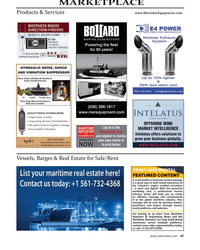 )
April 2024 - Maritime Reporter and Engineering News page: 47
)
April 2024 - Maritime Reporter and Engineering News page: 47.com Powering the fleet for 60 years! HYDRAULIC NOISE, SHOCK AND VIBRATION SUPPRESSOR Noise, Shock, VibraO on & PulsaO on in Quiet, Smooth Flow Out Oil Bladder Nitrogen (blue) Manufactured by MER Equipment Three Stage Noise & PulsaO on in ReducO on Chamber (206) 286-1817 www.merequipment.com QUALITY
-
 )
April 2024 - Maritime Reporter and Engineering News page: 42
)
April 2024 - Maritime Reporter and Engineering News page: 42OPINION: The Final Word Seeing the Ship as a System Shipping must engage with the decarbonization realities that lie ahead by changing the way it crafts maritime legislation to re? ect its place in the interconnected, interdependent world economy, said Eero Lehtovaara, ABB Marine & Ports. ABB Marine &
-
 )
April 2024 - Maritime Reporter and Engineering News page: 41
)
April 2024 - Maritime Reporter and Engineering News page: 41maritime environments: • GMDSS/NAVTEX/NAVDAT coastal surveillance and transmission systems • Offshore NDB non-directional radio beacon systems for oil platform, support vessel & wind farm applications • DGPS coastal differential global positioning systems • VHF port communication systems Nautel
-
 )
April 2024 - Maritime Reporter and Engineering News page: 38
)
April 2024 - Maritime Reporter and Engineering News page: 38, including collecting MARPOL liquid The tanker vessel Archangel, 274 meters long and 85,474 and solid waste, transporting personnel and provisions, and oil gt, was moored using the 3-ton pulling capacity of the moor- spill response services. Images courtesy Consulmar Crowley's New LNG Containerships Carbon
-
 )
April 2024 - Maritime Reporter and Engineering News page: 35
)
April 2024 - Maritime Reporter and Engineering News page: 35becoming as interconnected as onboard sys- size training materials, including micro-learning videos, gam- tems. Kongsberg Digital has integrated NORBIT’s oil spill ing apps, VR programs and online mentoring. detection system with its K-Pos DP system for simulation- “These digital methods are more effective
-
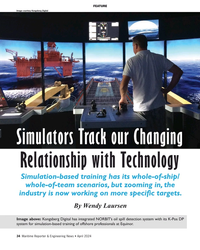 )
April 2024 - Maritime Reporter and Engineering News page: 34
)
April 2024 - Maritime Reporter and Engineering News page: 34scenarios, but zooming in, the industry is now working on more speci? c targets. By Wendy Laursen Image above: Kongsberg Digital has integrated NORBIT’s oil spill detection system with its K-Pos DP system for simulation-based training of offshore professionals at Equinor. 34 Maritime Reporter & Engineering
-
 )
April 2024 - Maritime Reporter and Engineering News page: 32
)
April 2024 - Maritime Reporter and Engineering News page: 32? xed wind. The subsidies won’t be a plentiful, and then a second on a luf? ng jib. This reduces the time it would there won’t be the same downturn in oil and gas that made all ordinarily take, weeks, to recon? gure the wiring of an ordi- the high-spec construction vessels available at attractive rates
-
 )
April 2024 - Maritime Reporter and Engineering News page: 25
)
April 2024 - Maritime Reporter and Engineering News page: 25vessels can MSC will see up to 20 new ships deliver to carry the equivalent of 30 C-17 transports. the ? eet in the next ? ve years. This includes new oil- Our Combat Logistics Force (CLF) is the key to keep- ing our ships at sea and in the ? ght, and sustain our forces ers, towing, salvage and rescue
-
 )
April 2024 - Maritime Reporter and Engineering News page: 21
)
April 2024 - Maritime Reporter and Engineering News page: 21along with our continued support to the in a UK design ? rm working in the North Sea marine industry,” said Langford. “We continue to hire key in- oil and gas platforms, the holy grail of rigorous dividuals and partner to provide best-in-class solutions.” R conditions in offshore energy production
-
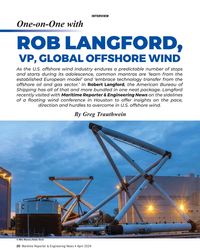 )
April 2024 - Maritime Reporter and Engineering News page: 20
)
April 2024 - Maritime Reporter and Engineering News page: 20and starts during its adolescence, common mantras are ‘learn from the established European model’ and ‘embrace technology transfer from the offshore oil and gas sector.’ In Robert Langford, the American Bureau of Shipping has all of that and more bundled in one neat package. Langford recently visited
-
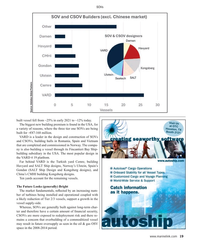 )
April 2024 - Maritime Reporter and Engineering News page: 19
)
April 2024 - Maritime Reporter and Engineering News page: 19more exposed to redeployment risk and there re- mains a concern that overbuilding of a commoditized vessel may result in future oversupply as seen in the oil & gas OSV space in the 2008-2014 period. www.marinelink.com 19 MR #4 (18-33).indd 19 4/5/2024 8:13:37 A
-
 )
April 2024 - Maritime Reporter and Engineering News page: 18
)
April 2024 - Maritime Reporter and Engineering News page: 18through dual fuel near shore Taiwanese market, which is also actively served by engines and (space for) a bunkering system. Currently metha- CTVs. Oil & gas offshore support vessels have been widely nol is a preferred energy carrier although hydrogen and liquid deployed to support construction logistics
-
 )
April 2024 - Maritime Reporter and Engineering News page: 17
)
April 2024 - Maritime Reporter and Engineering News page: 17or under construction in the North Euro- pean wind segment. Tier 2 and Tier 3 walk-to-work (W2W) vessels are cur- rently active in the segment, but as oil www.marinelink.com 17 MR #4 (1-17).indd 17 4/5/2024 8:40:33 A
-
 )
April 2024 - Maritime Reporter and Engineering News page: 16
)
April 2024 - Maritime Reporter and Engineering News page: 16charter to a wind turbine OEM or offshore wind in-built crane and gangway. farm operator to service and maintain equipment dur- ¦Tier 2: Generally, oil & gas tonnage (MPSVs, PSVs, ing the operations period of the wind farm. A typical etc.) with ? xed gangway, serving oil & gas and SOV will accommodat
-
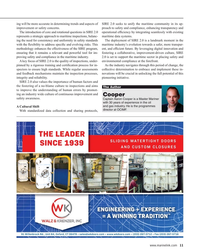 )
April 2024 - Maritime Reporter and Engineering News page: 11
)
April 2024 - Maritime Reporter and Engineering News page: 11wide culture of continuous improvement and Cooper safety awareness. Captain Aaron Cooper is a Master Mariner with 30 years of experience in the oil and gas industry. He is the programmes A Cultural Shift director at OCIMF. With standardized data collection and sharing protocols, THE LEADER SLIDING
-
 )
April 2024 - Maritime Reporter and Engineering News page: 10
)
April 2024 - Maritime Reporter and Engineering News page: 10users fully familiarize them- tion Report Program (SIRE 2.0). This initiative, led selves with the new regime, by using the portfolio of train- Tby the Oil Companies International Marine Forum ing materials and resources from OCIMF, has been key to (OCIMF), heralds a new era in vessel inspection, compliance
-
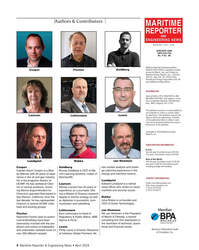 )
April 2024 - Maritime Reporter and Engineering News page: 4
)
April 2024 - Maritime Reporter and Engineering News page: 4is CEO of Ma- gic planning experience in the ter Mariner with 30 years of expe- rine Learning Systems, maker of energy and maritime sectors. rience in the oil and gas industry. MarineLMS. CONTACT INFORMATION: He is the programs director at Lundquist Email: [email protected] OCIMF. He has worked at Chev-
